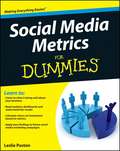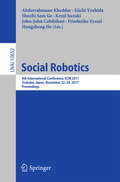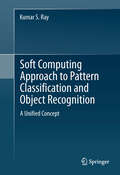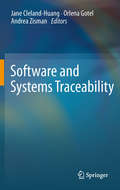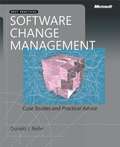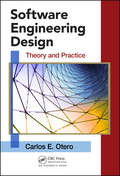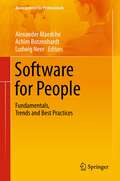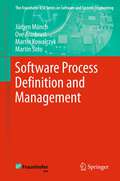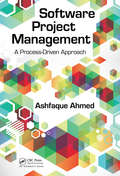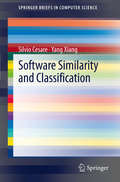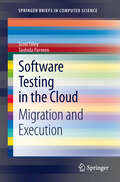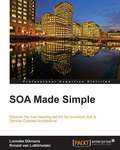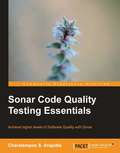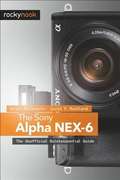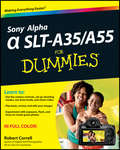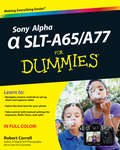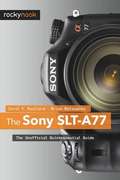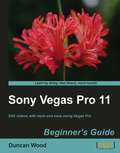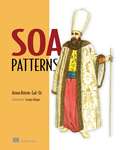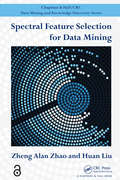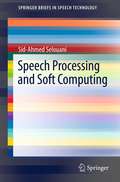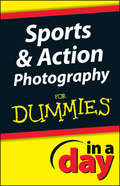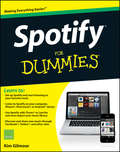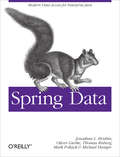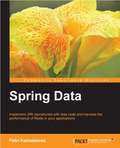- Table View
- List View
Social Media Metrics For Dummies
by Leslie PostonDiscover how to gauge your online success based on social media metricsWith so many social media monitoring and measurement tools available, it can be overwhelming to figure out which tool is right for you when it comes to calculating the success of your social media marketing efforts. This fun and friendly guide helps you determine which tool will serve you best for understanding your online audience.You'll learn to sift through all the information available about social media monitoring and metrics so that you can listen to what is being said about your business, read your analytic dashboard, understand what metrics mean for you, calculate your return on investment (ROI), and apply your findings to future social media marketing campaigns.Helps you wade through the plethora of social media monitoring and metrics to discover what elements are most applicable to your needsExplains the meaning behind the social media metrics tools so that you can understand how to make those results work for youShares examples of how to calculate both the financial and non-financial return on investment of your social media effortsIncludes real-world case studies that demonstrate how small and large businesses are using social media metricsWith this helpful book by your side, you will learn how to understand the information you acquire regarding your social media marketing efforts and then put that information to work for your business.
Social Robotics
by Abderrahmane Kheddar Eiichi Yoshida Shuzhi Sam Ge Kenji Suzuki John-John Cabibihan Friederike Eyssel Hongsheng HeThis book constitutes the refereed proceedings of the 4th International Conference on Social Robotics, ICSR 2012, held in Chengdu, China, in October 2012. The 66 revised full papers were carefully reviewed and selected from numerous submissions. The papers are organized in topical sections on affective and cognitive sciences for socially interactive robots, situated interaction and embodiment, robots to assist the elderly and persons with disabilities, social acceptance of robots and their impact to the society, artificial empathy, HRI through non-verbal communication and control, social telepresence robots, embodiments and networks, interaction and collaboration among robots, humans and environment, human augmentation, rehabilitation, and medical robots I and II.
Soft Computing Approach to Pattern Classification and Object Recognition
by Kumar S. RaySoft Computing Approach to Pattern Classification and Object Recognition establishes an innovative, unified approach to supervised pattern classification and model-based occluded object recognition. The book also surveys various soft computing tools, fuzzy relational calculus (FRC), genetic algorithm (GA) and multilayer perceptron (MLP) to provide a strong foundation for the reader. The supervised approach to pattern classification and model-based approach to occluded object recognition are treated in one framework , one based on either a conventional interpretation or a new interpretation of multidimensional fuzzy implication (MFI) and a novel notion of fuzzy pattern vector (FPV). By combining practice and theory, a completely independent design methodology was developed in conjunction with this supervised approach on a unified framework, and then tested thoroughly against both synthetic and real-life data. In the field of soft computing, such an application-oriented design study is unique in nature. The monograph essentially mimics the cognitive process of human decision making, and carries a message of perceptual integrity in representational diversity. Soft Computing Approach to Pattern Classification and Object Recognition is intended for researchers in the area of pattern classification and computer vision. Other academics and practitioners will also find the book valuable.
Software and Systems Traceability
by Orlena Gotel Jane Huang Andrea ZismanSoftware and Systems Traceability provides a comprehensive description of the practices and theories of software traceability across all phases of the software development lifecycle. The term software traceability is derived from the concept of requirements traceability. Requirements traceability is the ability to track a requirement all the way from its origins to the downstream work products that implement that requirement in a software system. Software traceability is defined as the ability to relate the various types of software artefacts created during the development of software systems. Traceability relations can improve the quality of a product being developed, and reduce the time and cost of development. More specifically, traceability relations can support evolution of software systems, reuse of parts of a system by comparing components of new and existing systems, validation that a system meets its requirements, understanding of the rationale for certain design and implementation decisions, and analysis of the implications of changes in the system.
Software Change Management: Case Studies and Practical Advice
by Donald J. ReiferDrawing from 30+ years of field experience, with case studies spanning industry, government, and academia, this practical guide illuminates the change-management approaches that lead to successful software process improvement.
Software Engineering Design: Theory and Practice (Applied Software Engineering Ser.)
by Carlos OteroTaking a learn-by-doing approach, Software Engineering Design: Theory and Practice uses examples, review questions, chapter exercises, and case study assignments to provide students and practitioners with the understanding required to design complex software systems. Explaining the concepts that are immediately relevant to software designers, it be
Software for People: Fundamentals, Trends and Best Practices
by Achim Botzenhardt Alexander Maedche Ludwig NeerThe highly competitive and globalized software market is creating pressure on software companies. Given the current boundary conditions, it is critical to continuously increase time-to-market and reduce development costs. In parallel, driven by private life experiences with mobile computing devices, the World Wide Web and software-based services, peoples' general expectations with regards to software are growing. They expect software that is simple and joyful to use. In the light of the changes that have taken place in recent years, software companies need to fundamentally reconsider the way they develop and deliver software to their customers. This book introduces fundamentals, trends and best practices in the software industry from a threefold perspective which equally takes into account design, management, and development of software. It demonstrates how cross-functional integration can be leveraged by software companies to successfully build software for people. Professionals from business and academia give an overview on state-of-the-art knowledge and report on key insights from their real-life experience. They provide guidance and hands-on recommendation on how to create winning products. This combined perspective fosters the transfer of knowledge between research and practice and offers a high practical value for both sides. The book targets both, practitioners and academics looking for successfully building software in the future. It is directed at Managing Directors of software companies, Software Project Managers, Product Managers and Designers, Software Developers as well as academics and students in the area of Software and Information Systems Engineering, Human Computer Interaction (HCI), and Innovation Management.
Software Process Definition and Management
by Martin Kowalczyk Jürgen Münch Martín Soto Ove ArmbrustThe concept of processes is at the heart of software and systems engineering. Software process models integrate software engineering methods and techniques and are the basis for managing large-scale software and IT projects. High product quality routinely results from high process quality. Software process management deals with getting and maintaining control over processes and their evolution. Becoming acquainted with existing software process models is not enough, though. It is important to understand how to select, define, manage, deploy, evaluate, and systematically evolve software process models so that they suitably address the problems, applications, and environments to which they are applied. Providing basic knowledge for these important tasks is the main goal of this textbook. Münch and his co-authors aim at providing knowledge that enables readers to develop useful process models that are suitable for their own purposes. They start with the basic concepts. Subsequently, existing representative process models are introduced, followed by a description of how to create individual models and the necessary means for doing so (i.e., notations and tools). Lastly, different possible usage scenarios for process management are highlighted (e.g. process improvement and software process simulation). Their book is aimed at students and researchers working on software project management, software quality assurance, and software measurement; and at practitioners who are interested in process definition and management for developing, maintaining, and operating software-intensive systems and services.
Software Project Management: A Process-Driven Approach
by Ashfaque AhmedTo build reliable, industry-applicable software products, large-scale software project groups must continuously improve software engineering processes to increase product quality, facilitate cost reductions, and adhere to tight schedules. Emphasizing the critical components of successful large-scale software projects, Software Project Management: A
Software Similarity and Classification
by Yang Xiang Silvio CesareSoftware similarity and classification is an emerging topic with wide applications. It is applicable to the areas of malware detection, software theft detection, plagiarism detection, and software clone detection. Extracting program features, processing those features into suitable representations, and constructing distance metrics to define similarity and dissimilarity are the key methods to identify software variants, clones, derivatives, and classes of software. Software Similarity and Classification reviews the literature of those core concepts, in addition to relevant literature in each application and demonstrates that considering these applied problems as a similarity and classification problem enables techniques to be shared between areas. Additionally, the authors present in-depth case studies using the software similarity and classification techniques developed throughout the book.
Software Testing in the Cloud: Migration and Execution
by Tauhida Parveen Scott TilleyFor a large, complex system, the amount of test cases in a regression test suite can range from a few hundred to several thousands, which can take hours or even days to execute. Regression testing also requires considerable resources that are often not readily available. This precludes their use in an interactive setting, further contributing to an inefficient testing process. Cloud computing offers the use of virtualized hardware, effectively unlimited storage, and software services that can help reduce the execution time of large test suites in a cost-effective manner. The research presented by Tilley and Parveen leverages the resources provided by cloud computing infrastructure to facilitate the concurrent execution of test cases. They introduce a decision framework called SMART-T to support migration of software testing to the cloud, a distributed environment called HadoopUnit for the concurrent execution of test cases in the cloud, and a series of case studies illustrating the use of the framework and the environment. Experimental results indicate a significant reduction in test execution time is possible when compared with a typical sequential environment. Software testing in the cloud is a subject of high interest for advanced practitioners and academic researchers alike. For advanced practitioners, the issue of cloud computing and its impact on the field of software testing is becoming increasingly relevant. For academic researchers, this is a subject that is replete with interesting challenges; there are so many open problems that graduate students will be busy for years to come. To further disseminate results in this field, the authors created a community of interest called "Software Testing in the Cloud" (www.STITC.org), and they encourage all readers to get involved in this exciting new area.
SOA Made Simple
by Lonneke Dikmans Ronald Van Luttikhuizen"SOA Made Simple" is a concise and indispensable handbook for finally understanding exactly what Service Oriented Architecture is. Split into three clear sections, in this book you'll learn from both theory as well as step-by-step implementation examples to aid in your understanding of this often poorly- articulated industry term.If you are an architect who wants to be completely clear in your understanding of what SOA is, then this book is essential. In fact, anyone (designer, developer, administrator or team lead) who is implementing or about to implement an architecture in an IT environment should not miss out on "SOA Made Simple". Some previous experience with general software architecture is required, but this guide will tell you everything you need to know about SOA in a clear and easy fashion.
Sonar Code Quality Testing Essentials
by Charalampos ArapidisThis is a step-by-step tutorial enriched with practical examples and the necessary screenshots for easy and quick learning. This book is for you if you are a Java developer or a Team Manager familiar with Java and want to ensure the quality of your code using Sonar. You should have a background with Java and unit testing in general.
The Sony Alpha NEX-7
by Brian Matsumoto Carol F. RoullardThe Sony Alpha NEX-7: The Unofficial Quintessential Guide provides a wealth of experience-based information and insights for owners of this exciting new camera. Authors Carol F. Roullard and Brian Matsumoto team up to help the new user navigate past the confusion factor that often comes with complex and powerful camera equipment. This book explores the features and capabilities of the camera in a way that far surpasses the user's manual. It guides you through the camera features with step-by-step setting adjustments and detailed how, when, and why explanations for each option. Every button, dial, switch, and menu configuration setting is explored in a friendly manner, with suggestions and tips for setup according to various shooting styles. The informative text is illustrated with screenshots and example images throughout, making it easy to follow along. The authors cover everything from the basic features of the camera to numerous advanced photographic applications. The first section of the book teaches the new user to start taking pictures immediately by using the camera's Intelligent Automatic mode. The second section covers how to begin taking more control by switching to the semi-automatic modes. Finally, you'll learn to take full manual control of the camera, allowing you to break some "rules" and capture images that are a unique reflection of your creative personality. Carol and Brian go beyond just the camera itself and share how third-party software and optional accessories can improve on the camera's standard commands. You'll even learn how the electronic viewfinder, the fixed mirror, and Sony's novel shutter design improve the camera's utility for critical scientific photography (i.e., photomicrography and photography through the telescope).The Sony Alpha NEX-7: The Unofficial Quintessential Guide will allow you to really take control of your camera, to push the envelope, and to have fun.
Sony Alpha SLT-A35 / A55 For Dummies
by Robert CorrellA practical, step-by-step guide to Sony's most popular new dSLRsSony's new a35 and a55 camera models offer a full range of dSLR features, including pre-sets and auto modes for beginners as well as full manual control over exposure and a unique translucent mirror option. This friendly For Dummies guide gets new dSLR users up to speed and helps more experienced photographers take full advantage of the many options these cameras offer. It covers all the basic camera controls and explains how to set up shooting modes, shoot video, master exposure and focus, edit images, and more.Sony's a35 and a55 models offer a full range of dSLR features and a translucent mirror option, this guide helps new and experienced photographers take full advantage of them allCovers setting up the camera, using all the basic and advanced controls, using auto mode, and shooting video Explores controls that handle exposure, flash, focus, and color, and how to make these elements work to create a great photoExplains image playback, review, and basic editingSony a35/a55 For Dummies gets you up and running with your new Sony dSLR quickly and helps you make the most of everything it has to offer.
Sony Alpha SLT-A65/A77 For Dummies
by Robert CorrellJust what you need to get up and running with Sony's new flagship dSLRs The Sony a77, with its 24. 3 megapixel sensor, full HD video capability, and translucent mirror system, is poised to be Sony's flagship dSLR camera. With many of the same features but at a lower price point, the a65 is the economy version. This guide will cover all the important steps for getting the most from either model. It shows how to set up the camera to get great shots immediately, explains all the controls and shooting modes, shows how to review images and make basic edits, and offers valuable advice on taking super photos using manual settings. Sony's new a65 and a77 dSLRs feature a huge megapixel sensor, HD video, generous ISO range, and the translucent mirror system unique to Sony This easy-to-follow guide helps you make the most of your investment with complete coverage of all the basic and advanced settings and shooting modes Covers shooting in auto mode, shooting HD video, and taking manual control over exposure, focus, and lighting Explains how to play back images and perform basic edits as well as how to manipulate flash, focus, and color to create top-quality photos With Sony a65/a77 For Dummies, bestselling photography author Robert Correll gives new Sony dSLR users confidence and helps them get everything they paid for in these exciting new Sony camera models.
The Sony SLT-A77
by Brian Matsumoto Carol F. RoullardThis book provides enthusiastic photographers with a wealth of information about the unique features of the Sony SLT-A77, an interchangeable-lens camera with an electronic viewfinder and a fixed, translucent mirror. The A77 differs from the current crop of DSLRs in its ability to use a phase detection focusing system throughout the entire picture-taking process, for both still photographs and videos. This provides an immediacy and responsiveness when using burst shots and creating HD videos that is unavailable in any other camera. In this guide, authors Carol Roullard and Brian Matsumoto teach you how to obtain exceptional photographs and videos as they cover everything from the basics of using the camera's automatic modes, to the more advanced aperture-priority, shutter-priority, program, and manual exposure modes. You'll also learn how best to take advantage of features such as the built-in dynamic range adjustment, sweep panoramic, GPS, colorization modes, facial detection and recognition, multiple shot exposures, and HD video. The authors provide you with an opportunity to improve your skills even further by discussing how third-party software and accessories can improve Sony's standard commands. You'll also learn about how the electronic viewfinder, fixed mirror, and Sony's novel shutter design improve the camera's utility for scientific photography through the microscope and telescope. Additional topics include:Advantages of the electronic viewfinder for previewing your photographs Using the accessory Sony shoe-mount flash Advantages of using the JPEG file format Advantage of having a fixed mirror and electronic first curtain shutter Settings for using the camera on a microscope and telescope Using the older Minolta Maxxum lenses
Sony Vegas Pro 11 Beginner’s Guide
by Duncan WoodThe book takes a clear, step-by-step approach to guide you through the process creating a video project with Vegas Pro. With each chapter, you will "level up" your video editing skills,Are you keen on creating professional quality videos? You know little or nothing about video editing and Vegas Pro? Then this book is a perfect fit for you to dive headfirst into video production with Vegas Pro.
SOA Patterns
by Arnon Rotem-Gal-OzSummarySOA Patterns provides architectural guidance through patterns and antipatterns. It shows you how to build real SOA services that feature flexibility, availability, and scalability. Through an extensive set of patterns, this book identifies the major SOA pressure points and provides reusable techniques to address them. Each pattern pairs the classic problem/solution format with a unique technology map, showing where specific solutions fit into the general pattern.About the TechnologyThe idea of service-oriented architecture is an easy one to grasp and yet developers and enterprise architects often struggle with implementation issues. Here are some of them:How to get high availability and high performanceHow to know a service has failedHow to create reports when data is scattered within multiple servicesHow to make loose coupling looserHow to solve authentication and authorization for service consumersHow to integrate SOA and the UIAbout the BookSOA Patterns provides detailed, technology-neutral solutions to these challenges, and many others, using plain language. You'll understand the design patterns that promote and enforce flexibility, availability, and scalability. Each of the 26 patterns uses the classic problem/solution format and a unique technology map to show where specific solutions fit into the general pattern.The book is written for working developers and architects building services and service-oriented solutions. Knowledge of Java or C# is helpful but not required.Purchase of the print book comes with an offer of a free PDF, ePub, and Kindle eBook from Manning. Also available is all code from the book.Table of ContentsPART 1 SOA PATTERNSSolving SOA pains with patternsFoundation structural patternsPatterns for performance, scalability, and availabilitySecurity and manageability patternsMessage exchange patternsService consumer patternsService integration patternsPART 2 SOA IN THE REAL WORLDService antipatternsPutting it all together—a case studySOA vs. the world
Spectral Feature Selection for Data Mining (Chapman And Hall/crc Data Mining And Knowledge Discovery Ser.)
by Zheng Alan Zhao Huan LiuSpectral Feature Selection for Data Mining introduces a novel feature selection technique that establishes a general platform for studying existing feature selection algorithms and developing new algorithms for emerging problems in real-world applications. This technique represents a unified framework for supervised, unsupervised, and semisupervise
Speech Processing and Soft Computing (SpringerBriefs in Speech Technology)
by Sid-Ahmed SelouaniSpeech Processing and Soft Computing includes coverage of synergy between speech technology and bio-inspired soft computing methods. Through practical cases, the author explores, dissects and examines how soft computing may complement conventional techniques in speech enhancement and speech recognition in order to provide robust systems. The material is especially useful to graduate students and experienced researchers who are interested in expanding their horizons and investigating new research directions through review of the theoretical and practical settings of soft computing methods in very recent speech applications.
Sports and Action Photography In A Day For Dummies (In A Day For Dummies)
by Jonathan StreetmanTake better actions shots with this terrific, 100-page e-book! From pro to hobbyist, from your child's first baseball game to the championship match, every photographer wants to be able to capture thrilling action shots. Now you can sharpen your photography skills with this fast-paced, In A Day For Dummies e-book that really zeros in on the specifics. See how to freeze action, add motion blur, and work with the variety of conditions you'll face when shooting live action. Focuses on techniques that help you successfully capture sports and live action photographs, such as freezing action or adding motion blur Covers getting the right gear, setting your camera for the shot, capturing the shot, editing the results, and more Includes a "Beyond the book" online component, where you can find step-by-step tutorials, videos, and a bonus lesson on creating a high-dynamic range sports photo Shows you techniques that work effectively on digital SLR cameras and point-and-shoot cameras Get Sports & Action Photography In A Day For Dummies and take action!
Spotify For Dummies
by Kim GilmourThe ultimate beginner guide to the groundbreaking music service, Spotify!Spotify is a free online streaming music platform that allows users to listen to songs on demand over the Internet--without having to buy or own the actual tracks. This fun and friendly guide walks you through how best to use this sweet-sounding service. Covering everything from using Spotify on selected mobile phones to creating and sharing your own playlists, Spotify For Dummies has it all. Experienced author Kim Gilmour details the ins and outs of this revolutionary music, from installing and setup to discovering new artists and taking your musical enjoyment to new levels. Explores the social networking aspects of Spotify and how to integrate with themHelps you navigate through the various editions of SpotifyShows you how to take Spotify with you on your mobile deviceEncourages you to merge your own music collection with SpotifyThis book is spot on! Start using Spotify today with this handy guide by your side.
Spring Data
by Mark Pollack Oliver Gierke Thomas Risberg Jon Brisbin Michael Hunger<p>This hands-on introduction shows you how Spring Data makes it relatively easy to build applications across a wide range of new data access technologies such as NoSQL and Hadoop. Through several sample projects, you’ll learn how Spring Data provides a consistent programming model that retains NoSQL-specific features and capabilities, and helps you develop Hadoop applications across a wide range of use-cases</p>
Spring Data
by Petri KainulainenThis book is a standard tutorial which provides step-by-step instructions and a lot of code examples that are easy to follow and help you to get started from page one. This book is suited for developers who are working with Spring-powered applications, and are looking for an easier way to write data access code that uses relational databases. Also, if you are interested in learning how you can utilize Redis in your applications, this is the book for you. This book assumes that you have got some experience with the Spring Framework and the Java Persistence API. No previous experience with Redis is required.
